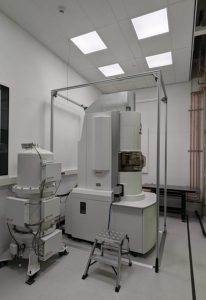Transmission Electron Microscope (TEM)
AMOLF acquired a unique instrument: a Transmission Electron Microscope (TEM). With this microscope researchers can now watch materials at the atomic scale and see what is happening over time and under the influence of light. This microscope is open to everyone with an academic or industrial affiliation at an hourly fee.
Technical specifications

The ‘JEOL NeoARM (S)TEM ‘combines atomic resolution electron imaging with light incoupling. Together with synchronized electron beam blanking, 4D-STEM and EDX this systems provides a powerful platform for material research.
Here are its technical specifications:
- JEOL NeoARM (S)TEM with Cold Field Emission Gun (CFEG, 0.3 eV FWHM energy spread)
- Wide gap pole piece configuration allowing for a wide range of in situ TEM holders
- ASCOR Cs corrector (TEM 0.14 nm resolution, STEM 0.082 nm resolution at 200 kV)
- IDES Laser Incoupling unit
- Standard laser: NKT FIU-15 laser with a NKT VARIA tunable filter from 400 nm to 840 nm and repetition rate from 0.15 to 78 MHz; setup can be modified depending on application with any fiber coupled lasers
- STEM detectors: annular bright field (ABF), annular dark field (ADF) and annular four-segmented detector (Quad SAAF)
- JEOL DrySD100GV EDX detector (100mm2, windowless, 133eV@Mnka resolution)
- IDES EDM Synchrony ( beam blanking down to 50 ns electron pulses)
- ASI 4D-STEM Timepix3 detector (event-driven direct electron detector with 1.56 ns event detection resolution)
- TVIPS XF416 R(ES) TEM Camera bottom mounted camera (48 fps @ 4k x 4k; up to 384 fps @ 512 x 1k)
In-take procedure
In order to help you with your training and measurements, we would like to learn more about your project. The in-take procedure follow the steps below to make the process as smooth as possible:
- Send an email to support.nanolab@amolf.nl with these specifics:
- A technical description of your sample(s) including:
- What do you want to know about your sample?
- What is the sample made of? What are the dimensions (thickness, nanoparticle size etc.) of the sample?
- What TEM grids are used?
- How are the samples prepared and cleaned?
- How many samples do you have?
- How often should these measurements be repeated?
- Other features which are important to your sample or measurement.
- The following contact information
- Name
- Institute/company
- Group/department
- Group leader/supervisor
- Function/Role: <BSc., MSc., PhD, PostDoc, Technician, Staff member, etc.>
- Start date
- End date (we use this information to automatically revoke your rights when you end or project/study/education/etc.)
- Budget number: (required for billing of equipment usage. Ask your groupleader or financial contact person which number is used for you or your project)
- Specifically mention that you are applying for the TEM.
- A technical description of your sample(s) including:
- An in-take interview will be planned with the Nanolab staff and the responsible TEM technician or operator. During this interview the specifics of the project will be discussed.
- After the in-take interview, the training(s) or measurement will be planned. The duration of a training depends on the complexity of the measurements.
- After the training has been completed reservations can be made on nis.nanolabnl.nl. The training staff will give you access to make reservations for the TEM independently.
TEM facility user rates
For the TEM facility, two rates are distinguished:
- Public Rate
Users from public research communities e.g. Universities, NWO, etc.
- Private Rate
Other users, private parties
| Cost Item (per person) | Public User (€) | Private User (€) |
| Rate for the microscope per hour | 100 ex BTW | 200 ex BTW |
| Rate for the operator per hour | 80 ex BTW | 160 ex BTW |
Please note that these rates are different from the AMOLF Nanolab Amsterdam user rates. The TEM facility is supported by the Nanolab, but is considered a separate facility.
Contact
Are you interested or do you have questions? Then send an email message to support.nanolab@amolf.nl.


